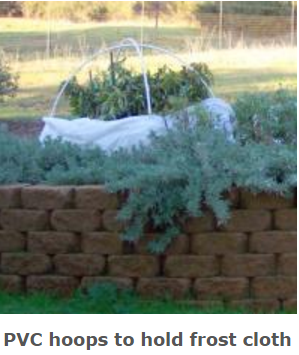Advice for the Home Gardener from the Help Desk of the
UC Master Gardener Program of Contra Costa County
Client's Request: Good Morning Gardeners! I drive by your beautiful community garden (MGCC's “Our Garden” in Walnut Creek) every morning on the way to my daughter's preschool in the Shadelands area. I've noticed that you've already covered your citrus trees for frost protection. I have a small backyard orchard with 5 citrus trees...4 of them with fruit on now, and I have not covered them yet.
I have these dark colored tree covers that I bought and use (basically a large cloth bag, kind of like an outdoor patio chair cover with a drawstring at the base of the tree), but the directions that came with them advise removing them by day so the tree can receive light. It's a hassle putting them on by night and taking them off each morning. What do you use? Do they allow light in and for how many days in a row can they safely stay on the tree without harming the tree? Can the same covers be used in the springtime when my mandarin is flowering to keep bees off and keep the fruit seedless? Thank you so much for your advice! Happy Holidays.

You probably noticed that the covers at Our Garden are white, and are designed to let some light through so they can be left on for several days at a time. You can buy such “frost blankets” at garden centers or online- one brand that I know of is called 'Agribon' They are a lightweight, non-woven material, and come in different weights. You also asked about using this for keeping bees off your mandarins: I would not use the heavier frost blanket for this, but you could use the lighter weight 'row cover' which is often used to keep various moths and bugs off vegetables. Most nurseries and/or hardware stores should stock this or similar types of frost cloth.
Here is a link to an online source which sells these “cloths”, and it has some good information on its use. This is a commercial link, and we do not endorse any particular business, but I include it as it may be helpful to you. https://www.groworganic.com/frost-and-sun-protection/frost-protection/frost-blankets.html. There are many other online suppliers that can be found by Googling “frost protection cloth”.
For now, the covers that you have been using most likely are doing a good job, but being dark in color need to be removed during the day to let light to the plant. If you can provide a frame around the plant to keep the cloth from touching the leaves, that will work best. Here is a UC link with helpful information: http://homeorchard.ucdavis.edu/8100.pdf
You also asked how long the covers can be left on. I can't give you an exact number of days, but the plant should be fine for a few days at a time. I personally use these covers, and I generally leave them attached to the framework, and try to pull them back on warm days to get some airflow and/or sunlight to the plant. I make hoop structures out of re-bar and PVC pipe, and find that kitchen clips (such as you would use for chip bags) are a quick and easy way to attach the cloth to the frame. You can see pictures of such a structure here: //ucanr.edu/blogs/blogcore/postdetail.cfm?postnum=22776 You can anchor the PVC hoops with 2 foot lengths of re-bar pounded into the ground (make sure the diameter of the re-bar is less than the internal diameter of the pipe!)
I hope this is helpful, and if you have further questions please don't hesitate to get back to us.
Happy Holidays to you, and good luck with your citrus.
Help Desk of the UC Master Gardener Program of Contra Costa County (SMW)
Note: The UC Master Gardeners Program of Contra Costa's Help Desk is available year-round (except the last two weeks of December) to answer your gardening questions. Except for a few holidays, we're open every week, Monday through Thursday for walk-ins from 9:00 am to Noon at 75 Santa Barbara Road, 2d Floor, Pleasant Hill, CA 94523. We can also be reached via telephone: (925)646-6586, email: ccmg@ucanr.edu, or on the web at http://ccmg.ucanr.edu/Ask_Us/ MGCC Blogs can be found at http://ccmg.ucanr.edu/HortCoCo/ You can also subscribe to the Blog (//ucanr.edu/blogs/CCMGBlog/)